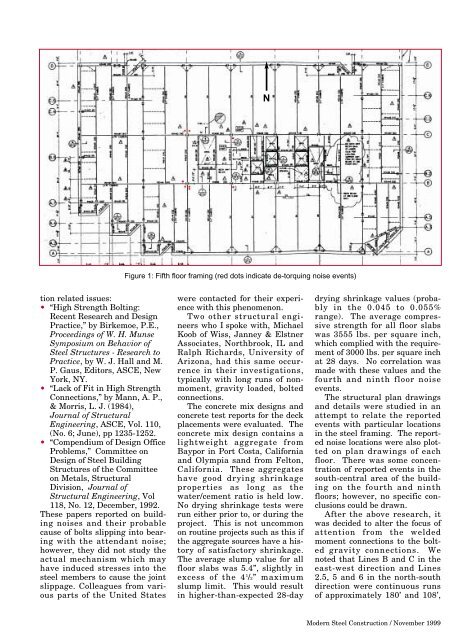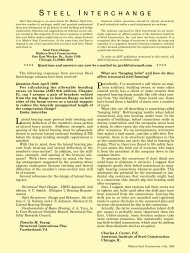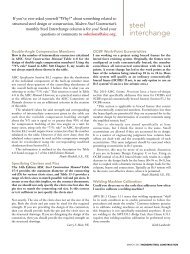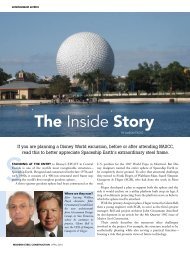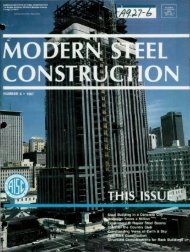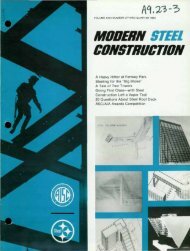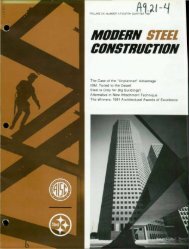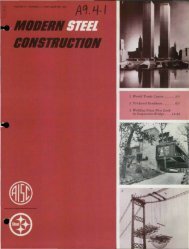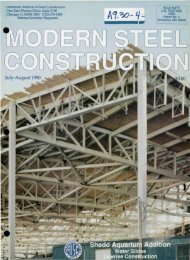THE BANGING BOLT SYNDROME - Modern Steel Construction
THE BANGING BOLT SYNDROME - Modern Steel Construction
THE BANGING BOLT SYNDROME - Modern Steel Construction
You also want an ePaper? Increase the reach of your titles
YUMPU automatically turns print PDFs into web optimized ePapers that Google loves.
tion related issues:<br />
“High Strength Bolting:<br />
Recent Research and Design<br />
Practice,” by Birkemoe, P.E.,<br />
Proceedings of W. H. Munse<br />
Symposium on Behavior of<br />
<strong>Steel</strong> Structures - Research to<br />
Practice, by W. J. Hall and M.<br />
P. Gaus, Editors, ASCE, New<br />
York, NY.<br />
“Lack of Fit in High Strength<br />
Connections,” by Mann, A. P.,<br />
& Morris, L. J. (1984),<br />
Journal of Structural<br />
Engineering, ASCE, Vol. 110,<br />
(No. 6; June), pp 1235-1252.<br />
“Compendium of Design Office<br />
Problems,” Committee on<br />
Design of <strong>Steel</strong> Building<br />
Structures of the Committee<br />
on Metals, Structural<br />
Division, Journal of<br />
Structural Engineering, Vol<br />
118, No. 12, December, 1992.<br />
These papers reported on building<br />
noises and their probable<br />
cause of bolts slipping into bearing<br />
with the attendant noise;<br />
however, they did not study the<br />
actual mechanism which may<br />
have induced stresses into the<br />
steel members to cause the joint<br />
slippage. Colleagues from various<br />
parts of the United States<br />
Figure 1: Fifth floor framing (red dots indicate de-torquing noise events)<br />
N<br />
were contacted for their experience<br />
with this phenomenon.<br />
Two other structural engineers<br />
who I spoke with, Michael<br />
Koob of Wiss, Janney & Elstner<br />
Associates, Northbrook, IL and<br />
Ralph Richards, University of<br />
Arizona, had this same occurrence<br />
in their investigations,<br />
typically with long runs of nonmoment,<br />
gravity loaded, bolted<br />
connections.<br />
The concrete mix designs and<br />
concrete test reports for the deck<br />
placements were evaluated. The<br />
concrete mix design contains a<br />
lightweight aggregate from<br />
Baypor in Port Costa, California<br />
and Olympia sand from Felton,<br />
California. These aggregates<br />
have good drying shrinkage<br />
properties as long as the<br />
water/cement ratio is held low.<br />
No drying shrinkage tests were<br />
run either prior to, or during the<br />
project. This is not uncommon<br />
on routine projects such as this if<br />
the aggregate sources have a history<br />
of satisfactory shrinkage.<br />
The average slump value for all<br />
floor slabs was 5.4”, slightly in<br />
excess of the 4 1 /2” maximum<br />
slump limit. This would result<br />
in higher-than-expected 28-day<br />
drying shrinkage values (probably<br />
in the 0.045 to 0.055%<br />
range). The average compressive<br />
strength for all floor slabs<br />
was 3555 lbs. per square inch,<br />
which complied with the requirement<br />
of 3000 lbs. per square inch<br />
at 28 days. No correlation was<br />
made with these values and the<br />
fourth and ninth floor noise<br />
events.<br />
The structural plan drawings<br />
and details were studied in an<br />
attempt to relate the reported<br />
events with particular locations<br />
in the steel framing. The reported<br />
noise locations were also plotted<br />
on plan drawings of each<br />
floor. There was some concentration<br />
of reported events in the<br />
south-central area of the building<br />
on the fourth and ninth<br />
floors; however, no specific conclusions<br />
could be drawn.<br />
After the above research, it<br />
was decided to alter the focus of<br />
attention from the welded<br />
moment connections to the bolted<br />
gravity connections. We<br />
noted that Lines B and C in the<br />
east-west direction and Lines<br />
2.5, 5 and 6 in the north-south<br />
direction were continuous runs<br />
of approximately 180’ and 108’,<br />
<strong>Modern</strong> <strong>Steel</strong> <strong>Construction</strong> / November 1999


